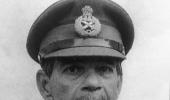Valhalla is undoubtedly enriched by the presence of Wing Commander Unnikrishnan Gangadharan Kartha.
He would have already convened the 'fall in' and regaled his friends with tales of the distant land that they once inhabited.
Air Commodore Nitin Sathe (retd) salutes the IAF legend.

Wing Commander Unnikrishnan Gangadharan Kartha took off for Valhalla on October 28, 2023 having battled the big C for quite a while.
'Valhalla' had been his favourite destination in his writings, and Unni Sir often spoke about how he would order a 'fall-in' on reaching there, gathering all the helicopter pilots in heaven for a spirited drink and celebration.
After retiring from the Indian Air Force in March 1994, Unni Sir took to blogging, adopting the pseudonym 'Cyclic'.
Just as a helicopter without proper cyclic control can be wayward, Unni Sir harnessed his wandering thoughts with a pen that seemed as precise as cyclic control, producing a plethora of vivid stories.
This unique style of storytelling remained exclusively his own for as long as I can recall.
My memories of this dashing, hardcore maverick pilot trace back to 1989, when, as the head of the oldest helicopter unit of the Air Force-104 HU, he was tasked to convert his unit from the grand old Chetak helicopters to the state of the art Russian Mi-35 'Hind'.
He had moved to Pathankot with his 'boys'; and when they were not learning how to fly the new aircraft, they would be huddled together discussing innovative tactics and strategies to become the most lethal tank busters.
Unni had a rich background as an experimental test pilot trained in France and had been a veteran of live missions in Sri Lanka.
With his profound and in-depth knowledge of aviation and aviating, he was the go-to authority for all inquiries related to helicopter operations.
I distinctly remember the aerodynamics and weapon classes he conducted in the crew room at Pathankot.
While he wore down the white chalk held between his rather thick fingers on the blackboard, the stub of his cigarette in the other hand would nearly burn his fingers before he lit another, all the while passionately expounding on how armament could be precisely delivered on target.
Not only about flying, Unni Sir could churn many a gripping tale from history with such vivid description; naming people and places from history -- and one could visualise the battle unfolding right there in the bar where we sat, captivated with his words, drink in hand.

Just over a year ago as I researched stories for my book on the Kargil Conflict and the 1971 War, Unni sir shared a captivating account of how the Mukti Bahini was trained by the Indian Army and Indian Air Force in 1971; and how the Bangladesh air force took shape from what was known as the 'Kilo flight'.
While I recorded what he spoke, he humbly requested, "I say Nitin, I don't want my name to be mentioned anywhere. I don't seek the limelight".
In a discussion on the vulnerability of Attack Helicopters in the modern day battlefield, on our squadron group, Unni sir was very candid and direct about his thoughts.
"The only way to use this machine is offensively; and all those of you who fear being shot down-you are not living up to your potential", he said, putting an end to the debate.

In his final days as he prepared to depart, he imparted his insights on the command and control aspects of Attack Helicopters in the Indian context from his hospital bed, With his vocal chords failing, he spoke in a throaty whisper, but his inimical style remained as he managed to put across his point of view.
When I called to share that the article had been published, he had lost his voice completely.
However, he conveyed his congratulations to me through our squadron doctor who was with him.
Doc later told me, "Unni Sir is in pain, but he won't show it. He is as bubbly and full of josh as we saw him as a Wing Commander at Bhatinda. But, it is just a matter of time...."

Unni Sir, an alumnus of the Rashtriya Indian Military College and the National Defence Academy, started his career as a transport pilot in the IAF.
He later converted to helicopters and went on to become an experimental test pilot.
He was chosen to command the newly inducted Mi-35 helicopters at 104 Helicopter Squadron at Bhatinda.
To delve into the extraordinary stories penned by this legend, you must visit his blog (external link).
I may be too modest to describe what he wrote or how great a man he was, but his writings will reveal his incredible essence.
Only his own words can adequately capture the remarkable individual he was.
Valhalla is undoubtedly enriched by the presence of Unni Gangadharan Kartha.
With a day having passed, he would have already convened the 'fall in' and regaled his friends with tales of the distant land that they once inhabited.

As one of his admirers wrote in his obituary:
''Unni uncle, to me, needs no introduction. He was a pilot, a warrior, and a wordsmith who had the extraordinary ability to breathe life into the most vivid imaginations of an unwavering Air Force veteran. His storytelling had a magical quality that could even bring a six year old to fits of laughter.
'It's a challenge to determine whether he excelled more as a pilot or as a wordsmith, but I would venture to say that he was an even finer human being. Beneath his candid exterior and perhaps a touch of social awkwardness, beat a heart that was perpetually caring and affectionate towards anyone fortunate enough to be within his sphere of influence.
Blue Skies and Happy Landings till we meet again, Cyclic!










